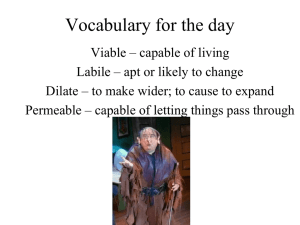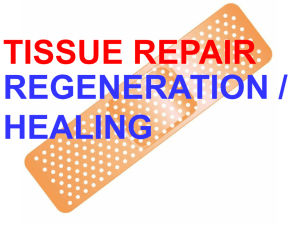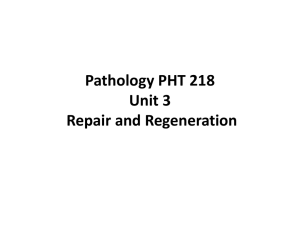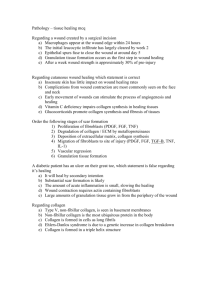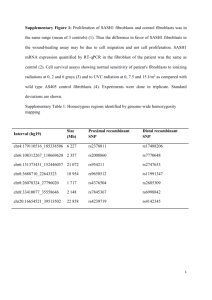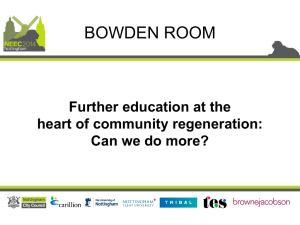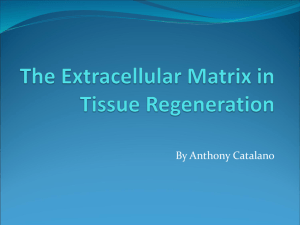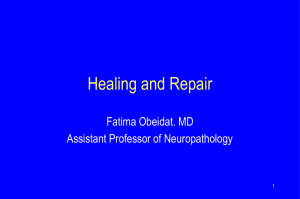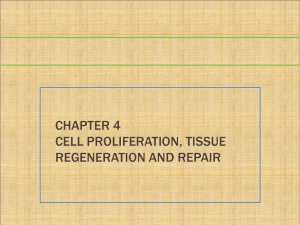Tissue Repair
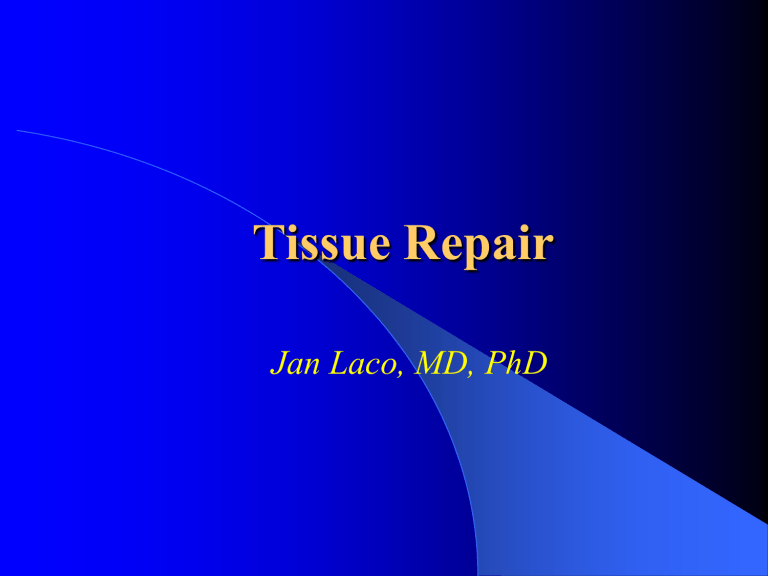
Tissue Repair
Jan Laco, MD, PhD
Tissue Repair
may start early after tissue damage
regeneration
– by parenchymal cells of the same type
reparation
– replacement by connective tissue (fibrosis)
– result - scar
Regeneration and Reparation
regeneration
–
– restoration of normal structure and function persistence of supportive „tissue skeleton“ necessary
BM of epithelia
reticulin frame in liver
reparation
– restoration of normal shape x function is impaired or lost
– parenchyma replaced by fibrous tissue
Tissue types
permanent
– nonproliferative in postnatal life
– neurons (?), cardiomyocytes (?)
stable
–
– regeneration as response to injury parenchyma – liver, pancreas, renal tubules
– mesenchymal cells, endothelium
–
–
– labile
–
– continuous regeneration from stem cells (self-renewal) hematopoietic cells in bone marrow surface epithelia – skin, oral cavity, vagina, cervix duct epithelia – salivary glands, pancreas, biliary tract mucosas – GIT, uterus, fallopian tubes, urinary bladder
Cell-ECM interactions
not only cells!
EMC plays important role in healing
interstitial matrix – by fibroblasts
basement membrane – by fibroblast and epithelium
components
–
– collagen (18 types) – I, III, IV, V; tensile strength elastin (+ fibrillin) – return to normal structure after stress
– glycoproteins - adhesion, binding ECM to cells
(fibronectin, laminin)
– proteoglycans and hyalouronans – lubrication (gels)
Cell-ECM interactions
ECM function
– mechanical support
– determination of cell polarity
– control of cell growth
– maintenance of cell proliferation
– establishment of tissue microenvironments
– storage of regulatory molecules
Replacement of necrotic tissue
resorption by macrophages
dissolution by enzymes
replacement by granulation tissue
–
– uniform mechanism irrespective of inicial trigger the same microscopic appearance
–
–
–
– angiogenesis migration and proliferation of fibroblasts deposition of ECM maturation and reorganization
Granulation tissue
new-formed connective tissue, apparent from 3rd day
thin-walled capillary vessels
fibroblasts
loose extracellular matrix
stimulation
– PDGF, VEGF, FGF, TGF, TNF, EGF
inhibition
– INFalfa, prostaglandins, angiostatins
control
– cyclins, cyclin dependent kinases
Granulation tissue
pink soft granular appearance
richly vascularized
highly cellular
myxoid matrix
inflammatory cells
e.g. surface of wounds, bottom of ulcers
Angiogenesis
neovascularization
x vasculogenesis (embryonic process only)
highly complex phenomenon
angiogenic factors (FGF, VEGF)
antiangiogenic factors
healing, collateral circulation, tumors
Fibrosis and Remodeling
scar formation
fibroblasts
myofibroblasts
– spindle cells of both fibroblastic and smooth muscle phenotype
– production of collagen fibres
– wound contraction
Fibrosis and Remodeling
abundant collagen fibres bridging the defect
devoid of inflammatory cells
reepithelization of surface defect
– from skin appendages and/or from periphery
secondary changes
–
– calcification (dystrophic) ossification (metaplastic)
remodeling
– synthesis and degradation of ECM
– metalloproteinases (MPs), tissue inhibitors of MPs
Pathological aspects of healing
proud flesh (caro luxurians)
– excessive amount of GT
keloid
– excessive amount of collagen
hyaline plaques
– serous membranes (spleen, pleura)
